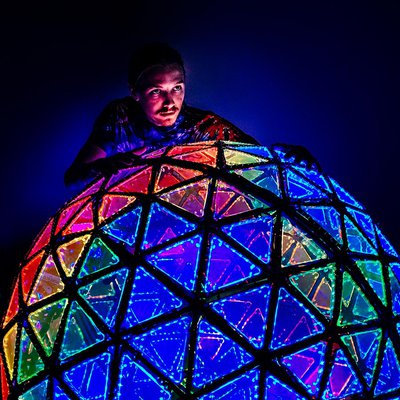
As a child, Yona Appletree spent his summers at the Oregon Country Fair, helping his mother sell tie-dyed clothes — and he continued to do so as he matured, manning his mother’s booth until 2010. Appletree grew up at the Fair, watching it slowly change. Now, as a computer programmer specializing in interactive art, he wants to help the OCF evolve.
“My earliest memories of the Fair are from about 1992,” Appletree says. “I was about 6 or 7 at the time; it was a little rougher, not in a bad way, but a little wilder.”
Now he thinks the Fair is more regulated — and that increased oversight hasn’t necessarily paralleled a changing of aesthetic, with the Fair retaining most of its rustic charms.
But Appletree thinks that may need to change if the Fair wants to survive.
“Ultimately the young people are going to inherit the Fair,” he says. “It’s going to grow to what the next generation wants.”
Appletree, along with partners Wayne Skipper and Kenyon Acton, now runs Light At Play, a local company that designs and creates interactive lighting systems. Light At Play uses a combination of Lucite, a transparent acrylic material being championed as an alternative to glass, along with LED light strips and custom software to produce large dome structures that respond to users’ movements and sounds to produce vibrant, surreal color displays on the dome’s surface. In other words, the domes are virtual canvases.
Light At Play sends its interactive art pieces to Burning Man and music festivals, like Mohawk Valley Music Festival this August, and has won several design awards. Last year the OCF allowed Light At Play to place the installation called the Jr. Dome outside the Fair gates, but not inside, something Appletree and Skipper attribute to a guarded but not totally unreceptive OCF protocol for accepting newer phenomena without first gauging fairgoers’ responsiveness.
Appletree says that the fairgoers’ response was positive, remembering a moment last year after the late-night fire show ended, when a throng of campers streamed out of the gates, walking along the path that led them right past the Jr. Dome.
“I was sitting on top of the dome and this crowd sort of poured out, and there was a little eddy of several hundred people standing around,” Appletree says.
As the Jr. Dome shot a swirling rays of light into the sky, watchers seemed enthralled and drawn to its presence.
Despite working with technology that may seem out of place among the wooded paths and booths at OCF, Appletree says that the effect Light At Play’s installations create really isn’t all that different from the Fair’s existing aesthetic, a point he hopes the Fair will notice and embrace.
“It wasn’t intentional, but I grew up around the tie-dye and never had any interest in dying clothes,” says Appletree. “Now the rainbow (acrylic and LED) panels are very much in the same artistic vein.”